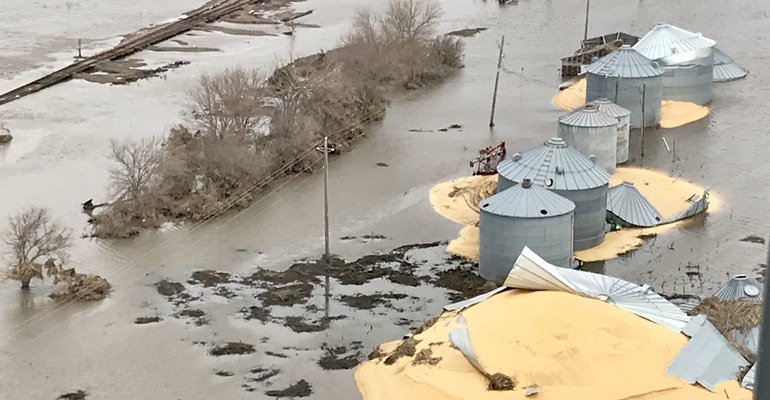September 18, 2019

Farmers affected by natural disasters in 2018 and 2019 can apply for help through USDA’s Wildfire and Hurricane Indemnity Program Plus. Sign-up began Sept. 11 for WHIP+.
“Extreme weather has greatly impacted Iowa’s ag producers over the last several years, and 2019 is no exception,” says Amanda De Jong, executive director for USDA’s Farm Service Agency in Iowa. “With record amounts of crops prevented from planting nationwide and other devastation, more than $3 billion is available through this disaster relief package passed by Congress and signed by President [Donald] Trump in early June.”
WHIP+ will be available for producers who suffered eligible losses of certain crops in counties with a presidential emergency disaster declaration or a secretarial disaster designation (primary counties only). Disaster losses must have occurred in 2018 or 2019. Also, producers in counties that did not receive a disaster declaration or designation may still apply for WHIP+ but must provide supporting documentation to establish that the crops were directly affected by a qualifying disaster loss.
Eligibility for this program
A list of counties receiving qualifying disaster declarations and designations is available at farmers.gov/recover/whip-plus. Because grazing and livestock losses, other than milk losses, are covered by other disaster recovery programs offered through FSA, those losses are not eligible for WHIP+.
Eligible crops include those where federal crop insurance or Noninsured Crop Disaster Assistance Program (NAP) coverage is available, excluding crops intended for grazing. A list of crops covered by crop insurance is found at USDA’s Risk Management Agency.
The WHIP+ payment factor ranges from 75% to 95%, depending on level of crop insurance coverage or NAP coverage a producer obtained for the crop. Those who did not insure their crops in 2018 or 2019 will receive 70% of the expected value of the crop. Insured crops (either crop insurance or NAP coverage) will receive between 75% and 95% of expected value. Those who purchased the highest levels of coverage will receive 95% of the expected value.
At time of sign-up, producers will be asked to provide verifiable and reliable production records. If a producer is unable to provide production records, WHIP+ payments will be determined based on the lower of either the actual loss certified by the producer and determined acceptable by FSA, or the county expected yield and county disaster yield. The county disaster yield is the production a producer would have been expected to make based on eligible disaster conditions in the county.
Big demand for funding
WHIP+ payments for 2018 disasters will be eligible for 100% of their calculated value. WHIP+ payments for 2019 disasters will be limited to an initial 50% of their calculated value, with an opportunity to receive up to the remaining 50% after Jan. 1, 2020, if sufficient funding remains.
Both insured and uninsured producers are eligible to apply for WHIP+. But all producers receiving WHIP+ payments will be required to purchase crop insurance or NAP at the 60% coverage level or higher for the next two available, consecutive crop years after the crop year for which WHIP+ payments were paid. Producers who fail to purchase crop insurance for the next two applicable, consecutive years will be required to pay back the WHIP+ payment.
A new On-Farm Storage Loss Program is also included in WHIP+. This program will aid producers who suffered losses of harvested commodities such grain and hay that were stored in on-farm structures in 2018 and 2019.
Prevented planting for insured crops
Farmers faced significant challenges planting crops in 2019 in many parts of the country. All producers with flooding or excess moisture-related prevented planting crop insurance claims in calendar year 2019 will receive a prevented planting supplemental disaster (“bonus”) payment. It is equal to 10% of their prevented planting indemnity, plus an additional 5% will be provided to those who purchased harvest price option coverage.
Further details on implementation of 2019 prevented planting “bonus” on insured crops will be announced soon by USDA. Producers who suffered 2019 crop losses on insured crops do not need to sign up with their local FSA office at this time.
As under the 2017 WHIP program, the WHIP+ version for 2019 will provide prevented planting assistance to uninsured producers, NAP producers and producers who may have been prevented from planting an insured crop in the 2018 crop year and those 2019 crops that had a final planting date prior to Jan. 1, 2019.
For more information on FSA disaster assistance, contact your local USDA service center or visit farmers.gov/recover. For all available USDA disaster programs see USDA’s disaster resources website.
Source: USDA, which is responsible for information provided and is wholly owned by source. Informa Business Media and subsidiaries aren’t responsible for content in this information asset.
You May Also Like




